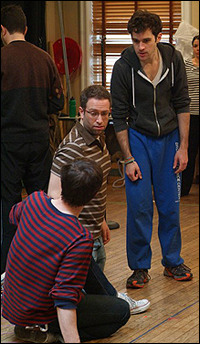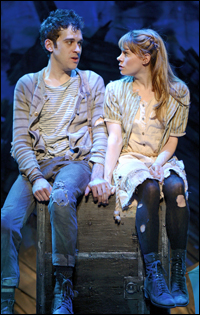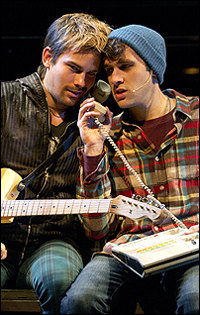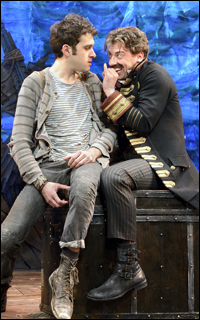
*
Cathy Rigby, Sandy Duncan and Mary Martin are among the leading ladies known for their performances as Peter Pan — or the Boy Who Would Not Grow Up. This time, a leading man is taking a stab at the lost boy. Adam Chanler-Berat, who was last seen on Broadway in the Pulitzer Prize-winning musical Next to Normal, returns to the title role of Peter and the Starcatcher, an intimate prequel to Peter Pan.
In early 2011 Chanler-Berat created the role of Boy in the New York Theatre Workshop production of Peter and the Starcatcher, written by Rick Elice and based upon the children's novel by Dave Barry and Ridley Pearson. Following its acclaimed downtown engagement, Chanler-Berat took on the role of New York City filmmaker Mark Cohen in the Off-Broadway revival of Rent. After a year of lead roles on the Off-Broadway circuit, the young actor is back on Broadway, holding tight to his trunk of Starstuff, fighting off the menacing Black Stache (played by "Smash" star Christian Borle) and telling the swashbuckling tale of a Peter Pan in the making.
It's been a busy year for you! Tell me about going from Peter and the Starcatcher at New York Theatre Workshop into Rent and back to Starcatcher.
Adam Chanler-Berat: Besides not having any kind of personal time, it's been a Dream Year for me. It's sort of how I want my years to always work in an ideal world. [As an actor], your hope is that you do a great, original Off-Broadway show, and when that ends, you move on to something else, and then eventually that Broadway show comes back around.
What was the vibe at the end of the New York Theatre Workshop run before you learned of the transfer?
ACB: It was hopeful, ambiguous and sad because there was a very good possibility that this was the last time we were going to perform this show. But there was a sort of static in the air. I think how they left it was, "We're going to try to make this happen," but I had to convince myself that it wasn't, so I could move on and do other things. It also sort of made sense in my mind that it might not happen — this tiny, little Off-Broadway show. I wasn't convinced of its broad appeal — that it would be right for Broadway houses or audiences. The New York Theatre Workshop audience is a drastically different demographic than the people who come to see Broadway shows.
 |
||
| Chanler-Berat (standing) in an early rehearsal for Starcatcher. |
||
| photo by Stephanie Warren |
ACB: I think that a few things transpired: our chemistry, as a company, has grown — it's really like a family; and then I think [playwright] Rick Elice gave — what might appear as subtle — a good amount of changes that were so well-received and reviewed. He certainly wasn't lazy in the transfer, and I think he's got a good brain for what works for a broader appeal. And, something happened with the chemistry of it all — the alchemy of the transfer was just right. I think that this show is in the best shape it's ever been in. The audiences here are really allowing themselves to enjoy it; at New York Theatre Workshop, it felt a little more tentative.
When looking at all of material on Peter Pan — books, movies, musicals — there are multiple endpoints, but you're creating the beginning. What was it like to work backwards?
ACB: I sort of became fascinated with the [public] obsession [with] the Peter Pan story…it's part of the fabric of humans. I'm fascinated with why it appeals so much to adults as it does to kids, so I did some research. I found some doctorate thesis papers, and I also fell into [following mythologist and writer of "The Hero With a Thousand Faces"] Joseph Campbell and the mythic version of the "hero's journey," which I think Peter Pan falls into. I wanted to know why that happened. That was almost as much fuel as reading the actual J.M. Barrie material.
When I was in college [at Marymount Manhattan], I started a theatre company with my friends — as a lot of young, frustrated artists do when you're in that environment and looking for a way to express yourself — and we did an original show. [Our group] was called Five Flights Theatre Company, and it actually still exists — they do a bunch of festivals every now and then — and we wanted to do original work. My proposal for our first project… I brought in a bunch of Shel Silverstein books and [said], "This is my youth." When I think of things that I was fascinated with when I was a kid, it was [his] books, poems and the illustrations. I was really enchanted by [them]. We ended up creating a piece of theatre called Don't Step on the Cracks, and it was a series of vignettes. It was done in the same sort of collaborative, bare-bones, multi-purposing-of-props idea that we're using here [with Peter and the Starcatcher]. The quote that comes to my head [from Don't Step on the Cracks] was something that I wrote in one of my scenes. It's about a 15-year-old who still sucks his thumb. He says, "I don't understand why we ever stop," in reference to sucking his thumb. I think, without really knowing yet, I had been obsessed with these ideas of Eternal Youth.
 |
||
| Chanler-Berat and Celia Keenan-Bolger in Broadway's Peter and the Starcatcher. |
||
| O&M Co. |
ACB: I think a lot of how the show is shaped is from the New York Theatre Workshop version [follow earlier development elsewhere]. There was a new movement director, Steven Hoggett, added on at New York Theatre Workshop… I think they always had that idea of using ropes to delineate the lines of the cabin, but the executing of it was done when Hoggett [joined the creative team]. When [co-director] Alex Timbers and Hoggett and [co-director] Roger Rees met, I feel like it really blossomed into what it is. The process — from what I remember — required a lot of patience. [Laughs.] Rope is a soft object, and it doesn't always abide by all of the things that you're asking it to do. It started out very technical, and they would give us the framework, and then we — the actors — could say, "I think this could be better. This can be faster. I have an idea here." So it felt very collaborative, as I hope it appears, but it's also incredibly technical. I think that we get away with the cheeky things that we do with the rope because they're sharp, and they're specific… Everything that we do is drilled and very precise.
It's very much an ensemble piece. You're playing the title character, yet you're such an essential part of the ensemble.
ACB: It's humbling. I think it's a really grounding experience for any actor. It's about generosity. It's about having your moment and then passing the ball over to somebody else, which is something that you learn about in theatre school and then forget about…in theatre school. [Laughs.] I think there's a time for ownership of yourself, [but] a lot of good theatre is about passing that ball onto the next moment, to the next plot line, to the next person, to the next joke. Roger's notes are always about lifting up the lines, so that the next person takes it and grabs it and runs with it and lifts up their line until it hits the next person.
 |
||
| Chanler-Berat (right) and Matt Shingledecker in Rent. |
||
| photo by Joan Marcus |
ACB: [He] becomes that boy who teeters on the edge of manhood. I think part of what he wants is to take care of people — to lead these boys [the two other orphans, Prentiss and Ted]. Orphans in the Victorian era were despised and discarded — he doesn't [understand] without Molly teaching him that he is worth something…that he's here for a purpose. He isn't just [here to] clean the cesspit and lug all of the schoolmasters' burdens around on his back; he actually has an important place in the world. That's his journey. That's what you get to watch. You get to watch him [grow] into somebody who has opinions and feels worthy of being free.
Can you talk about that relationship with Molly, played by Celia Keenan-Bolger? She is on the brink of being a mother figure and a love interest.
ACB: I think it's sort of gray. I dare to say that when you're a kid it's also gray — the relationship between a child and a parent is complicated. I think [his relationship with Molly] is very maternal, but it's also... He's 13 years old. He's been in a school full of boys, and he's becoming a man. It's that time when boys start to blossom — sexually — and I think that he definitely has strange feelings that he may or may not understand...
 |
||
| Chanler-Berat and Christian Borle in Broadway's Peter and the Starcatcher. |
||
| O&M Co. |
ACB: I've never worked with two directors before. It's difficult to negotiate as an actor, but what helps is that the two of them have such strong visions and tastes, and their tastes are often in the same universe. They're easy to trust in that way. They also come from such different worlds that I think what they provide for the cast and the show are so different. And, the show itself has been written to meet in the middle of their two universes: old-school and modern. [Peter and the Starcatcher] is where those two worlds collide. And, as an actor at this point in the process, we rely on them to take the temperature of the audience — to feel what they're getting and what they're not getting and what can be faster and what can be slower and what's making sense and what's not, so we really trust what Alex and Roger have to say. I think that they're just hugely talented. I've never worked with such visionaries. They have such a specific vision in their mind that I've never seen before, so I'm just happy to live in that world for a little.
Once the show starts, it feels like you're jumping on a rollercoaster ride.
ACB: It feels like that doing it, too. It feels like this show takes you up to the top of the piece, and then once you're there, you just sort of have to ride it, and the momentum [carries] you through.
My favorite line from the show is when Molly says, "It's supposed to hurt. That's how you know it meant something." It sums up Peter's journey. He fights hard for what he believes in.
ACB: I think you put it beautifully — that resonated with you. It's a testament to how true that is. What other line I always think of is, "Things are only worth what you're willing to give up for them," which is in the same universe because Peter spends his whole show wanting to get home. He finally does, but with getting that, he has to give something up. [He is on a] quest to [forever] be a boy because he's been raped of that as a child. He never had a boyhood. He never had fun. He never had a family. That idiom works in reverse. He gave up things, and now he gets things.
(Michael Gioia's work frequently appears in the news, feature and video sections of Playbill.com. Write to him at [email protected].)
Watch highlights from the show:










